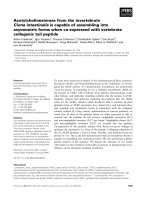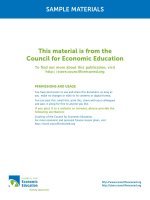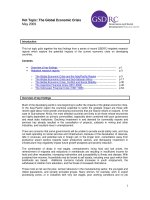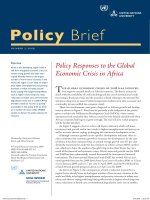From the current global economic crisis thinking of a development model in Vietnam
Bạn đang xem bản rút gọn của tài liệu. Xem và tải ngay bản đầy đủ của tài liệu tại đây (291.32 KB, 9 trang )
VNU Journal of Science, Economics and Business 27, No. 2 (2011) 94‐102
From the current global economic crisis - thinking of a
development model in Vietnam
Assoc.Prof.Dr. Pham Van Dzung*
Faculty of Political Economy, University of Economics and Business,
Vietnam National University, Hanoi, 144 Xuan Thuy, Cau Giay District, Hanoi, Viet Nam
Received 28 October 2010
Abstract. The current global economic crisis once again proves Karl Marx’s theoretical point. The
basic contradiction of capitalism - between the highly socialized productive force and capitalist
relation of production - has blowed up globally, causing severe economic, politic, and social
consequences. The intervention of states has softened this critical contradiction and restricted its
damage remarkably. In the near future, a global centre for economic regulation will appear.
However, the capability and power of states are limited. The inherent contradiction of capitalism
still exists and a similar crisis is inevitable in the future. Building a country with “wealthy people,
prosperious country, democracy, justice, cilvilization” is a goal that Vietnam has targeted. They
are also the common values of the humankind. To achieve this goal, Vietnam should learn lessons
from other countries. Development of a market economy is indispensable for Vietnam. However,
it is necessary to aware of advantages and disadvantages that exist in a market economy, including
crisis risks. The current global economic crisis has awoken every country. In fact, it could be
confirmed that Vietnam has a correct choice when choosing development model as “Socialistoriented market economy”. In essence, socialist orientation in market economic development of
Vietnam is to develop a market economy followed the shortened and sustainable development
model. Thanks to this model, the impacts of global economic crisis on Vietnam are less dramatic
than several countries; macroeconomic situation is relatively stable, economic growth is positive;
hunger elimination and poverty reduction gains achievements and so on. Those achievements
prove that Vietnamese Communist Party has successfully applied Marxist economic theory in the
new situation of Vietnam.
1. Milestones of the world economic crisis *
market, when mortgage accounted for 25% of
the total credit in the economy and the
American Home Mortgage - the largest home
mortgage corporation - applied for bankrupt.
Next, on 11 July 2008, the Indymac Bank with
assets worthy 32 billion USD was placed under
the control of the Federal Deposit Insurance
Corporation (FDIC). These are like the sign for
ups and downs events”. The crisis really
exploded in the middle of September 2008
when two financial groups, Fannie Mae and
The global economic crisis derived from the
real-estate credit crisis in the USA. Banks failed
to proceed with housing bussiness loans with
full attention about clients’ repayment ability.
The crisis showed its first symptom from the
third quarter of 2007 in the U.S financial
______
* Tel.: 84-912464494
E-mail:
94
P.V. Dzung / VNU Journal of Science, Economics and Business 27, No. 2 (2011) 94‐102
Freddie Mac, were nationalized. They were
giant financial groups in housing mortgage
loan, accounted for 50% of the U.S. market.
When the Merrill Lynch went bankruptcy due
to provision of substandard housing mortgage
loans, the Bank of America had to buy the
Merrill Lynch at $50 billion to rescue this
company. Additionally, the Lehman Brothers
collapsed, and applied for bankruptcy. On 17
September 2008, the U.S. Federal Reserve
(FED) lent the American International Group
(AIG) $85 billion to rescue this insurance group
from bankruptcy.
In England, the Northern Rock suffered a
huge loss when investing in stocks for the
substandard housing mortgage in the U.S. and
was on the edge of bankruptcy, it then was
nationalized.
The crisis started to spread to Europe and
Asia. In an attempt to prevent the crisis, the
Central Banks in U.S., England, China, Canada,
Sweeden, Switzerland and European Central
Bank (ECB) decreased basic interest.
Therefore, starting with the banks in U.S and
after a short time, the crisis had spread its swing
to a variety of economic fields, impacting
negatively on many economies at different
levels. Almost countries suffered dramatically
economic decline, increased unemployment rate,
and stagnated export due to decreased
consumption; the national reserve were
exhausted and budget deficits increased as the
governments had to provide huge stimulus
packages to save their economies.
A large number of urgent international
meetings were held to seek for the crisis. The
first meeting was held on 11 October 2008
among G7’s Central Banks Presidents and
Financial Ministers. The following meetings
were the Summit of G20’s leaders, U.N.
Secretary General, IMF’s leader and WB’s
leader in Washington from 15 to 16 October
2008, ASEM 7 Summit in Beijing and so on.
All the meetings focused on how each country
reacts and cooperates with each others to solve
the world economic and financial crisis. The
95
G20’s Summit urged the governments to
cooperate to overcome the crisis, halt the
recession, recover and grow the world
economy. Massive emergent solutions were
introduced by the governments to save the
econmies. In November 2008, money was
pumped into the economies, specifically: US$
1,300 by America, EUR 200 billion
(approximately US $260 billion) by EU, and
US$ 568 billion by China. Especially, ASEAN,
China, Japan, and Korea established a common
foreign reserve of US$ 80 billion in June 2009.
It couldn’t denied that the powerful
governmental interference did halt the crisis and
prevent negative impact(1).
2. Major causes of the world crisis and
economy tendency
It can be seen from the recent global
financial and economic crisis process, the major
causes derivered from substandard lending bank
systems,
weakness,
indiscipline
and
inopportune interfernce from governments. All
of these causes are apparently appropriate,
however, “subprime” and “visible”. To
investigate the root cause of the crisis, it is
essential to analyse the nature of developed
captalism economies, of which the US economy
is a typical example.
Developed countries nowadays, more or
less, support free market. This free market
mechanism attains a number of advantages,
playing an important role in socio-economic
achievements of those countries for hundreds of
years. However, the prominence of this
mechanism had led to economic recessions,
crises, especially the 1929-1933 Great
Depression, which laid an initial foundation for
the developent of the Keynesian. Since 1970s, the
Keynesian was excessively applied but it caused
negative effects. Therefore, the Neolibralism was
______
(1)
In National Workshop’s Discussion papers: General
economic model in the period of transition to socialism in
Vietnam: theoretical and practical basis. Hanoi - 2009, p 12-13.
96
P.V. Dzung / VNU Journal of Science, Economics and Business 27, No. 2 (2011) 94‐102
established and become predominant. Thanks to
economic achievements, many developed
countries became addicted to the Neolibralism
during 1980s-1990s.
The Neolibralism in essence has market
economy basis with government certain
interference. Economic liberation relies on
private ownership regulations, which allows an
effective exploitation and use of resources and
provides advantages for the rich. Indeed, this is
a modern market economy of Capitalism. K.
Marx mentioned the development cycle of
capitalist market economy. When chasing for
profits, entrepreneurs keep investing and
expanding their production and bussiness.
Rapid growth of the U.S and other developed
countries in the 1990s fell in the cycle
development regulations. Therefore, recession
cames after prosperity. Since 1999, developed
countries witnessed a slow-downed rate of
economic growth. At that time, some
economists had predicted a huge economic
crisis to happen. In this situation, the
governments
fixed
market
mechanism
malfunctions.
Neverthless,
they
still
implemented liberalisation policies, of which
the financial liberalisation was the most
dangerous. This symtom was appealed
significantly in the American financial market,
where financial institutions got a free pass for
large substandard lending, banks were allowed
to invest in stock market and especially housing
securities while expanding their housing loans
and real-estate investment insurance. In a
nutshell, financial liberalisation and profit
making target caused serious an unbalance
between financial and real-estate markets.
The imbalance was exaggerated by lowinterest policy aiming for economic growth
stimulus by the Federal Reserve (FED). In
2000, the basic interest rate announced by FED
was 6%. By mid 2003, the rate dropped to
1%(2). Apparently, commercial banks decreased
______
(2)
Dinh Van An,(PhD). Hoang Thu Hoa (co-author):
Overcoming challenges, opening opportunities for sustainable
development. Finance Publisher. Hanoi - 2009. P23.
their lending interest rate. Simultaneously,
housing price in 2001-2005 in the U.S.
increased dramatically by 54%. Hence, the realestate business turned out to be “superprofitable” and received a large amount of
money from commercial banks and financial
institutions as a result. The financial
liberalisation policy distracted the U.S.
government from maintaining a balanced cash
flow as a necessity. On the other hand, the
financial libralism brought about advantages for
the U.S. real-estaste market, and attracted
investment from commercial banks of other
developed countries(3). The imbalance reached
its peak and went out of the U.S. border.
In 2006, FED increased interest rate to
restrain inflation. This action affected realestate market immediately: price decreased,
transactions were hard to conduct. At that time,
commercial banks could not manage to retrieve
investment capital, which led to massive
bankruptcy. The U.S. government could not
control the national financial system and the
market failure was inevitable. Under the
globalization and financial liberalization
tendency, the financial market of every country
became more interdependent. As a result, the
failure in the US financial market led to the
failure of that market in other countries.
In consequence of giving prominence to
market power, depending on self-adjusting
market, governments were more like “a
follower” than “a preventer” in crisis. Only after
the economic-financial crisis had broken out, the
government of the US and others started to design
solutions. It can be seen that the failure was
originated from extreme liberalization of market
economy. This failure was started with “bubble”
in real-estate. If the Neoliberalism kept
predominent, the up-coming failures would
probably come from stock market, energy market
or tele-communication market... The selfadjusting market could probably lead to the
macro-economic imbalance, and economic crisis
was unavoidable.
______
(3)
I.b p24
P.V. Dzung / VNU Journal of Science, Economics and Business 27, No. 2 (2011) 94‐102
The current world economic crisis has once
again proven that the Marxist theory is correct.
The basic conflict of the Capitalism which is
between the increasing socialized nature of
productive forces and Capitalist relations of
production, broke out all over the World with a
large number of negative impacts on the
economy, politics and society. The interference
of bourgeois states could only ease the
seriousness of this conflict and restrain the
negative effect of the crisis.
3. Thinking of development pathway of
Vietnam
Vietnam’s development goals are to
continously enhance people’s material and
spritual life, aiming for “wealthy people,
prosperious country, justice, democracy,
cilvilization”. These goals originated from the
Socialist model by K.Marx and F.Engels and
from the reality of Vietnam through decades of
Vietnam Communist Party’s leadership. The
former war for national liberation and today’s
Socialism development of Vietnamese both aim
to realize these goals.
“Wealthy people, prosperious country,
justice, democracy, cilvilization” are common
values of human race. The development of a
market economy is essential to achieve these
goals, which has been proven by realities from
Vietnam and the world. Nonetheless, market
economy persists of not only advantages but
also failures with crisis risk. Since the first
transitional phase of market economy
mechanism, the Vietnamese Communist Party
and the Vietnamese Government focused on
enhancing its advantages and simultaneously
restraining its disadvantages and failure.
Vietnam designed and applied the development
model of “Socialist oriented market economy”
Socialist orientation in market economic
development of Vietnam is organised and
implemented by the State, the whole politic
system, under the leadership of Vietnamese
Communist Party, relying on conceiving nature,
97
laws of market economy tendency and the
initial characteristic of Socialism, in order to
adjust the market economy to contribute to
Socialist development and aiming for “wealthy
people,
prosperious
country,
justice,
democracy, civilization”
“Wealthy people, prosperious country,
justice, democracy, civilization” are our
nation’s dream for a long time and also the
common values of human race. With various
approaches, at different paces, and with
different kinds of failure, all countries and
nations are yielding to this goal. To catch up
with the developed countries, Vietnam has to
take a short-cut. Socialism must base on
intensive socialization, thus market economy is
prerequisite to develop Socialism. Developing
market economy takes a long orderly way.
Hence, taking a short-cut is foremost to arrive
in Socialism, standing as the first content of
Socialism orientation in developing market
economy.
The western countries have harshly
experienced primmary accumulation of capital
for hundreds of year to develop the market
economy. Developing countries have long been
Imperialist conolies, being exploited and
predominated over for hundreds of year.
Nowadays, these countries are still kept
obsolete and highly dependent. Therefore, it is
not a quick and easy way to develop their
market economy. Nationalist bourgeois took the
lead in national and democratic revolution in
some
countries.
After
gaining
the
independence, these countries chose Capitalist
way and experienced the duplicated process of
former developed capitalist countries with
extremely higher price. In the case of Vietnam,
the Vietnam Communist Party’ s leadership has
been the utmost factor to make differences. The
Vietnamese under Party’s leadership had
successfully swept French and Japanese troops
out off the country, winning a giant victory in
the Resistance against American, and advancing
to Socialism by passing the stage of Capitalism
development. The leadership of Vietnam
98
P.V. Dzung / VNU Journal of Science, Economics and Business 27, No. 2 (2011) 94‐102
Communist Party is the utmost political
premise for Vietnam to take a short-cut
development.
Market economy has become popular
worldwide recently. In pioneer countries,
market economy has reached advanced
development
stage.
In
regards
with
globalization and economic integration, there is
a chance for Vietnam to approach and inherit
the achievements gained by former developed
countries. It is an exterior factor, supporting
Vietnam to take a short-cut development.
Despite a short time of market economy
development, Vietnam has obtained notable
results. The premise for market economy
development have been established, including
variation of possessions, democraticization in
politics, society, acceleration of resource
accumulation, synchronization of economy
structure. In mid February, EU has approved
the assessment of market economy recognition
in Vietnam. EC’s assessment says Vietnam has
gained important milestones in transition to
market economy(4). Vietnam has fully met the
first criterion and made advancement in the
second criterion. In the last three criteria, the
assessment shows that Vietnam has some
certain advancement; however, there is still
room for improvement. Vietnam is striving for
full regconition of market economy in 2018,
which is absolutely possible. Hence, it will take
Vietnam 33 years to develop market economy
from 1986 (the starting point) and Vietnam is
capable to take a short-cut development.
______
(4)
The 5 criteria which EC use to assess market economy are:
• Degree of State influence over the allocation of resources
and decisions of enterprises.
• Absence of State-induces distortions in the operation of
enterprises linked to equitizations and absence of use of
non-market trading or compensation systems.
• Existence of an adequate system of corporate
governance.
• Respect of property laws (including intellectual property
laws) and existence of a functioning bankruptcy regime.
• Existence of a genuine financial sector which operates
independently from the State subject to sufficient
guarantee provisions and adequate supervision.
The mankind history has experienced
vicissititudes. All countries strived to be
prosperious and perpetual. However, their
attempt did not receive what they deserved:
many empires collapsed, many civilizations
were destroyed and a number of nations and
ethnics decayed. Not until later decades of
modern history, certain physical conditions for
formation of various ideas, concepts on
sustainable development did turn up and
become more profound and complete. The
development of former industrialised countries
concentrated mainly on production. It is a fact
that developed production and inequal income
distribution are responsible for social conflict
and cause development negative results.
Therefore, at the begining of the 1970s,
research and development activities brought
improving income distribution into focus.
Thereupon, the idea of development was
changed into economic growth interdependent
with social equality and porverty reduction.
Nevertheless,
since
rapidly
devastated
environment challenged the development in the
beginning of 1980s, environment protection has
appeared to be the third goal of development.
And during that time, the term “sustainable
development“ came into view.
Thenceforth, a great deal of definitions and
concepts on sustainable development have been
introduced in international conferences and
seminars. In 1987, WB’s definition stated
“sustainable development is development that
meets the needs of the present without
compromising the ability of future generations
to meet their own needs“. This definition is
simple but it has laid initial foundation for later
researches which are increasingly serious. The
concept of sustainable development was further
clarified at the 2002 Johannesburg Earth
Summit on Sustainable Development in South
Africa. Sustainable development is a process
with interdependent and mutually reinforcing
pillars as economic development, social
development, and environmental protection.
Thus, sustainable development have received a
P.V. Dzung / VNU Journal of Science, Economics and Business 27, No. 2 (2011) 94‐102
great deal of attention and become national
development goal.
Vietnam cannot stand apart from the world
development tendency. The development of
market economy in Vietnam is to benefit our
people, to fulfill the requirements for human
development process, targeting at “wealthy
people,
prosperious
country,
justice,
democracy, cilvilization”. The development
would simultaneously solve the three issues of
i) achieving stable and high economic growth
rate and gradually enhancing economic growth
quality ii) restraining and minimizing social
issues such as rich and poor gap, social evils,
ect. iii) protecting natural resources and
environment, preserving ecological balance. In
that event, sustainable development is the
second content of Socialist orientation in
market economy development in Vietnam.
Using Socialist orientation in market
economy development during recent years,
Vietnam has gained valuable outcomes towards
sustainable development.
* Government - Market relationship: The
government has played a substantial role in
developing market economy in Vietnam. With
the assistance of developing multi-element
economy, opening the door for integration,
developing new economic structures and
institution and adjusting economy regulating
mode and tool, the government has established
foudations for the formation and development
of market economy in Vietnam.
The government has played a substantial
role in forming market economy institutions.
Legal system, mechanism, policy, regulations
to regulate economics activities are being
developed and completed. Vietnamese
economy today comprises of variety of
possessions, economic elements and each
element has to compete with each others,
creating a driving force for eco-social
development; distribution institution has been
constituted and evenly implemented with
distribution principle of market economy and
Socialism. Performing distribution based on
99
market principle has created motivation for ecosocial activities. In the mean time, distribution
policy of the government has helped to perform
social equality. Business environment has
become more transparent and convenient.
Market elements and market types are getting
more developed and comprehensive.
In the past few years, the manner of
goverment intervention has been changed
positively. The use of indirect tools becomes more
popular. Market rules have taken effective. Price,
interest rate, wage,... are determined in the
market. Vietnam market has merged with the
world. Vietnam has participated in many
organisations in the area and worldwide.
Vietnam has sucessfully managed the 2008
inflation and economic recession in 2009. In the
global downturn context, Vietnam is one of a
few countries having positive economic growth
rate. Politic and social situation remains stable.
Vietnam has been considered to be one of the
active developing economies in the world.
* On the relationship between economic
growth and social equality advancement and
environment protection: Fast economic growth
is a pressing matter for Vietnam. Thanks to the
government’s proper policies, mechanisms, and
management, Vietnam’s GDP growth rate was
reasonably high at 8.2% during 1991-1995,
7,5% during 1996-2000, approximately 7.5%
during 2001-2005. Despite being affected by
the world financial crisis, GDP of 2008 still
increased by 6.18% compared to the number of
2007. And the growth rate in 2009 reached
5.32%. Owing to high economic growth rate
through years, Vietnam’s economic potential and
position have been improved considerably. From
being one of the poorest countries in the world,
income per capita in Vietnam has increased to
USD 1024 in 2008(5). Vietnam has joined the
group of countries with low average income.
In conjunction with rapid economic growth,
Vietnamese Communist Party and Vietnamese
government have paid high attention to social
______
(5)
Calculated according to figures in "Statistical Yearbook
2008". Statistics Publishing House. Hanoi - 2009. P 37, P 71
100
P.V. Dzung / VNU Journal of Science, Economics and Business 27, No. 2 (2011) 94‐102
issues. The majority of population in Vietnam
shares the benefit of economic growth.
According to Ministry of Labor, Invalids and
Social Affair, the proportion of poor households
in Vietnam has dropped from 58% in 1993 to
16% in 2006 and 14.8% in 2007.There is a
decrease of 300,000 poor households every year
on average. If the economy keeps growing at
the above mentioned rate and social policies are
well implemented, Vietnam will achieve the
committed Millenium Goal to halve the number
of poor population by 2015(6).
During 2006 and 2007, approximately
3,172,000 jobs were created, of which 75% was
from socio-economic development programs. In
2 years, there were 160,000 people, working
overseas under definite contracts, increasing the
total number of workers overseas to 460,000(7).
Vietnamese
Communist
Party
and
Government are concerned to develop culture,
healthcare, and education. Thus, systems of
education, healthcare, culture, communication,
sports have been improved remarkbly in the
recent years. Current intellecture rate in
Vietnam is 94%. Primary school education in
Vietnam has been unversalized in 2005 and
secondary school education is going under the
process. Social welfare was diversified. Social
insurance, health insurance system is
experiencing great development, heading to
universal health insurance. Health care system
has been improved to be unbiased and effective,
assuring people’s health is cared and protected.
The Government continues to put investment into
upgrading health care and precaution facilities,
designing and improving policy for allowance,
health insurance for social-policy beneficiaries
and the poor. High-tech and private health care
services have been flourished(8). Therefore,
Vietnamese life expectancy has increased from
67.8 to 71.3 years.
______
(6)
Figures and Events, No 2 - 2009, P26.
Communist Review, No 2 - 2008, P35
(8)
VCP: Documents of National Congress (10th). Nation
Politics Publishing House. Hanoi - 2006. P 101-102.
(7)
Generally, Vietnamese Communist Party
and Government have paid fully and
comprehensively attention to Socialism
orientation in working with social issues.
Equality is viewed from both angles: equality of
opportunity and equality of results. Thanks to
correct direction and appropriate policies,
Vietnam has achieved notable outcomes in social
issues. Vietnam’s HDI has risen from 0.539 in
1995 to 0.709 in 2006 and 0.733 in 2007 and
2008, ranking respectively 102/174 in 1995,
179/177 in 2006 and 105/177 in 2007 and 2008(9).
In spite of being a developing country,
Vietnam is concerned to preserve natural
resources and environment. Vietnam has
attempted to preserve, restore and replant
forests in order to perform The Millenium
Development Goals. The proportion of
coverage has increase to 33.2% in 2000 and
39% in 2008. Hence, there is 0.6% of added
forest coverage area annually. Vietnam has
been enforcing the project of “5 milion hectars
newly planted forest”. Local authorities have
been focusing on planting new watershed,
protective forest; preserving, restoring and
enriching existing forests; implementing
solutions for counter-deforestation. Meanwhile,
Vietnam has conducted considerable attempts
in soil preservation to maintain biological
origin and diversity. After 10 years of
implementing The Convention on Biological
Diversity, Vietnam has 126 natural reservoirs of
2.5 milion ha, increasing by 28% compared to
pre-entering period. Reservoirs, national forests
have been preserved and maintained with
biological diversity. Vietnam strives for
increasing proportion of preserved soild to 11.6%
in 2010. Investment in biological diversity, which
currently accounted for 20-30% of total
investment into environment, is to increase
evenly. Vietnam has attached much importance to
sewage, exhaust fumes processing, issued and
implemented many related policies.
* Economic integration and independence
protection. Market economy requires non-stop
______
(9)
Figures and Events, No 3 - 2009.
P.V. Dzung / VNU Journal of Science, Economics and Business 27, No. 2 (2011) 94‐102
expanding economic zone. In the context of
globalization, it is essential to integrate and
open the economy. Vietnam has actively and
initiatively integrated into the world economy.
Vietnam has become member of important
international organizations such as ASEAN,
APEC, WTO. Vietnam has opportunity to
develop market relationship rapidly more than
ever before. At the same time, Vietnamese
economy is able to overcome the disadvantages
such as capital shortage, obsolete technology
and making use of advantages.
Vietnam is still able to be independent of
designing development strategies, economic
poilicies and managing macro-economy.
Vietnam has succeeded in restraining impact of
global down-turn. Being independent in
economic issue is the premise for protecting
independence in politics, culture and society.
Although Vietnam still has to face with
series of issues: economic growth is lowquality, certain population group are likely to
be reimpoverished, quality of education and
health care services have not met the demand,
resources and environment preservation has
many problems, state management has been
still powerless... However, achievements in
economy development, solving social issues,
environment protection, world economic
integration are very important factors, which
allow to affirm that Vietnam has “firm steps”
101
on the way to achieve "wealthy people,
prosperity, justice, democracy and civilization”.
Consequently, thanks to the socialism
orientation in taking a short-cut and sustainable
market economy development, the global
economic crisis’s impacts on Vietnam was
fairly light, macro-economy is relatively
stability, economic growth is high and stable,
the solutions for social and environmental
issues gain many achievements.... All of the
results mentioned above prove that the model
“Socialist oriented market economy” is entirely
consistent with Vietnam.
References
[1] Dinh Van An, Hoang Thu Hoa (co-author), 2009,
Overcome challengers, create opportunities for
sustainable development. Finance Publisher. Hanoi
[2] Vietnamese Communist Party, 2006, Document of
The 10th National Party Congress, Hanoi.
[3] General economic model in the period of transition
to socialism in Vietnam: theoretical and practical
basis, National Workshop’s Proceeding: Hanoi 2009
[4] General Statistics Organization, 2009: Stastical
Yearbook 2008. Statistics Publishing House, Hanoi.
[5] Figure and Events Review. No 2, 3, 2009
[6] The Communist Review. No 2, 2008, tr.35
[7] />9/2009-06-10.html
[8] . 27/02/2010.
Từ cuộc khủng hoảng kinh tế toàn cầu, suy ngẫm về mô hình
phát triển ở Việt Nam
PGS.TS Phạm Văn Dũng
Khoa Kinh tế Chính trị, Trường Đại học Kinh tế,
Đại học Quốc gia Hà Nội, 144 Xuân Thuỷ, Cầu Giấy, Hà Nội, Việt Nam
Tóm tắt: Cuộc khủng hoảng kinh tế toàn cầu một lần nữa chứng minh những luận điểm của Karl
Marx là đúng. Mâu thuẫn cơ bản của chủ nghĩa tư bản giữa lực lượng sản xuất xã hội hoá cao với quan
hệ sản xuất tư bản chủ nghĩa đã bùng lên trên toàn cầu, gây ra những hệ quả nặng nề về kinh tế, chính
102 P.V. Dzung / VNU Journal of Science, Economics and Business 27, No. 2 (2011) 94‐102
trị và xã hội. Sự can thiệp của các nhà nước đã góp phần làm dịu bớt mâu thuẫn này và hạn chế được
tổn thất do cuộc khủng hoảng gây nên. Trong tương lai không xa, một trung tâm điều tiết kinh tế toàn
cầu có thể xuất hiện. Tuy nhiên, khả năng và quyền lực của các nhà nước là có hạn. Mâu thuẫn cố hữu
của chủ nghĩa tư bản sẽ vẫn tồn tại và một cuộc khủng hoảng tương tự là điều hoàn toàn có thể xảy ra
trong tương lai. Việt Nam đặt mục tiêu xây dựng và trở thành một đất nước “giàu mạnh, dân chủ, công
bằng, và văn minh.” Đây cũng là giá trị chung của toàn nhân loại. Để thực hiện mục tiêu này, Việt
Nam cần học tập kinh nghiệm của các nước đi trước. Phát triển nền kinh tế thị trường là lựa chọn tất
yếu của Việt Nam. Tuy nhiên, Việt Nam cần biết rằng nền kinh tế thị trường và trung tâm này có cả ưu
điểm và hạn chế, trong đó chứa đựng cả những nguy cơ khủng hoảng. Cuộc khủng hoảng kinh tế hiện
nay đã làm thức tỉnh mọi quốc gia. Trên thực tế, có thể khẳng định Việt Nam đã đúng khi lựa chọn mô
hình phát triển “Nền kinh tế thị trường định hướng xã hội chủ nghĩa.” Định hướng xã hội chủ nghĩa
trong phát triển kinh tế thị trường của Việt Nam là phát triển nền kinh tế thị trường theo từng giai đoạn
rút ngắn và bền vững. Nhờ mô hình này, ảnh hưởng của cuộc khủng hoảng kinh tế toàn cầu mà Việt
Nam phải hứng chịu là nhẹ hơn so với nhiều nước; tình hình kinh tế vĩ mô ổn định hơn, duy trì tăng
trưởng kinh tế dương; công cuộc xoá đói giảm nghèo đạt được nhiều thành tích lớn,… Những thành
công này chứng minh rằng Đảng Cộng sản Việt Nam đã áp dụng thành công lý thuyết kinh tế theo chủ
nghĩa Marx trong điều kiện của Việt Nam.









